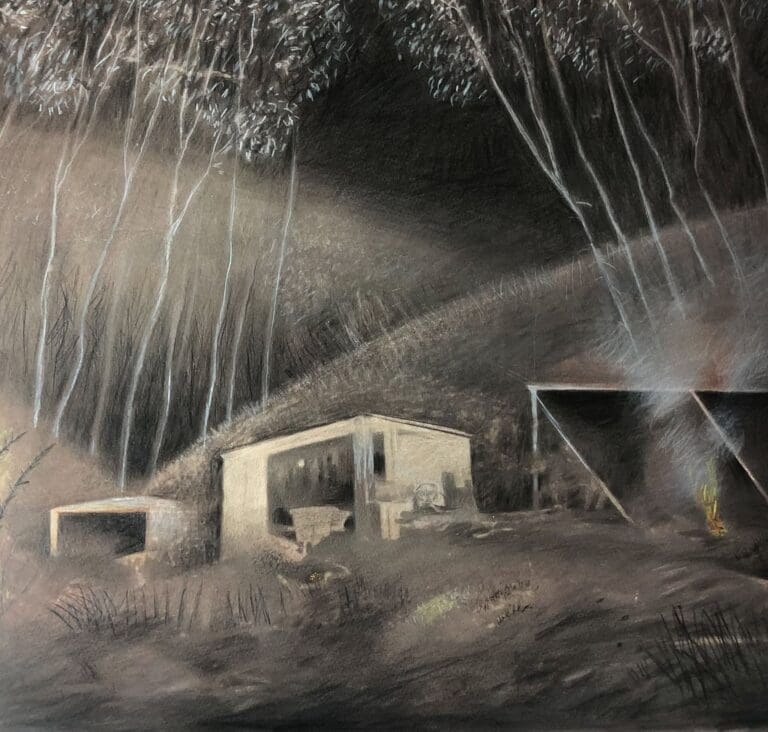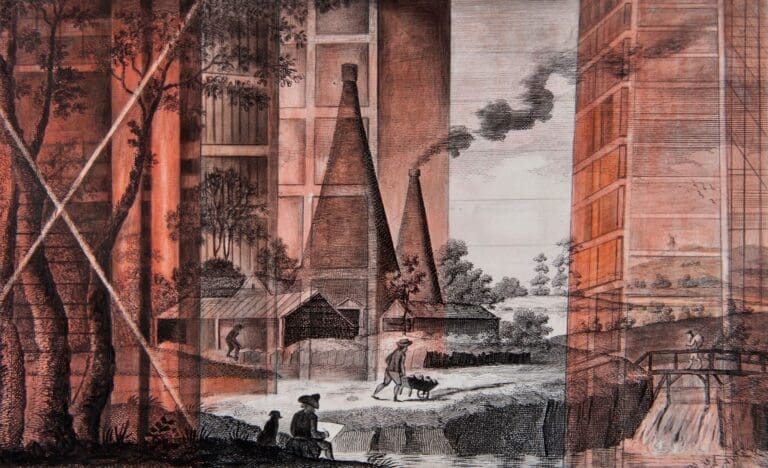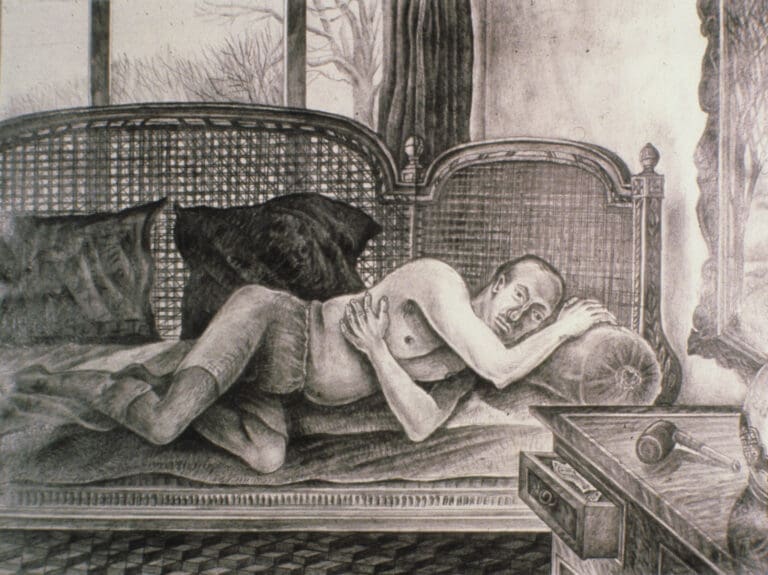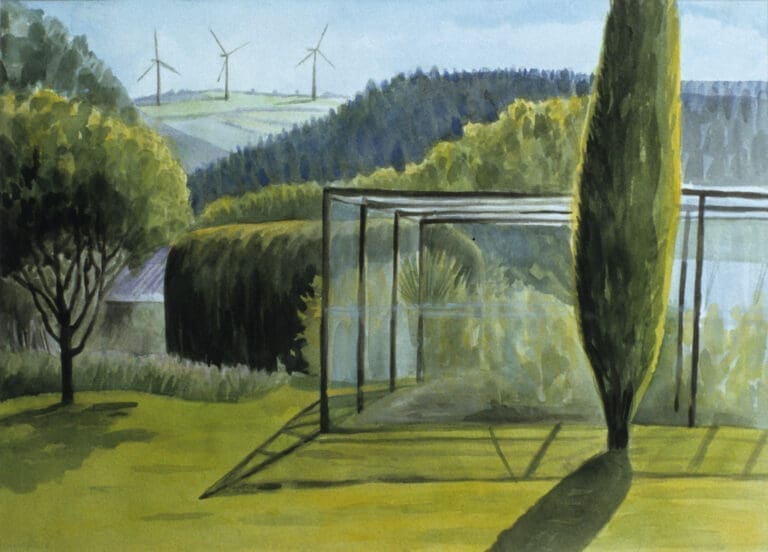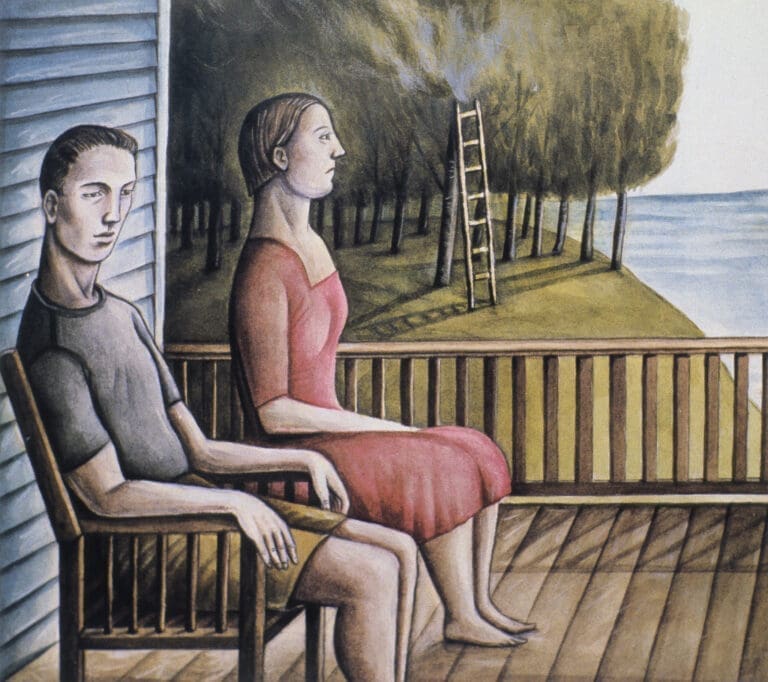I discovered Fox Talbot photographs as a schoolgirl, fascinated by the powerful sense of place at Lacock Abbey and by the stiff figures of the family and servants who lived on the estate in the 19th century – long dead, yet strangely intimate and alive. Working with them recently, I chose images that offered settings for a new cast of characters with sources found variously in the search files of ‘seated women’ and ‘standing men’ in the Fox Talbot Catalogue Raisonné archive, from a painting or film (the woman on a swing in Jean Renoir’s ‘A Day in the Country)’ or from an article in a newspaper reporting on current events. In this way artists can hide behind an original image which becomes a springboard to something that excites and connects them with their own internal life.
Soon after I started working with archive material, the theme of war began to appear in drawings. ’Angel,’ the earliest, was a response to an engraving of tunnels under Kings Cross Station from the 19th century Journal ‘The Builder.’ I wanted to tell a story about time and travel. Instead, an image of Auschwitz emerged, followed by the figures of two Angels. Non fiction books about World War Two and the holocaust were on my mind – and William Blake, with his reference to the power and protection of Angels. Living through politically unstable and secular times, I long for a more stable and peaceful world. Memories of earlier wars, genocide and repression are brought back by social media coverage of conflict in the Middle East and Ukraine. We are haunted by imagery of people walking across desolate landscapes with children, carrier bags, animals. Where is home for them?
The Volcano series continues to look at early 19th century photographs, using Italian landscapes as a backdrop for images of escape, displacement and war. Italy has always been a crucial influence, both culturally and artistically, especially the early Italian Renaissance works of Giotto, Masaccio and Piero. Spending time in a small village in Abruzzo, the landscapes seep into my work, overlaid by images from my own life and other unfolding events.
This is a continuing series about my sisters, my mother and myself, set partly at Seapoint near Dublin, where we went for childhood holidays. The windows of our house looked out across a mesmerising sea view towards Howth. An extraordinary light seemed to radiate onto the nearby Martello Tower and granite jetty where swimmers descended slowly into the sea all year round. The presence of water is part of these drawings, and is an ongoing theme in other works, including the spas and rivers of Islington and Kings Cross, London.
This solo exhibition at the Guardian Media 2009 commemorated the disappearing buildings and imagined a fictional architectural future for the railway lands of King’s Cross and St. Pancras. When I made my first work about the area in around 2005, King’s Cross was in transition – and still is. Living locally, I’ve always loved its grittiness, but then became fascinated by its transformation.
The Museum of London invited me to collaborate with their prints and drawings archives after visiting Remember Me, at the Guardian Media. Researching intuitively in the archives at the Museum of London and the London Metropolitan Archives, focusing on King’s Cross / St Pancras, I chose urban figurative narratives depicting ghosts, graveyards, death, health spas, foundling children, immigration and the built environment as starting points for collaborative drawings which evoked the passing of time through visual exchanges with the historic prints.
Kings Cross and its transformation still fascinates me and continues to appear in new work. I draw from life, from archival material or from found or personal photo reference. I am interested in the way drawing and photography can influence and collide with each other and trigger startling and unexpected associations. In recent ‘conversations’ with photographs I might begin with no knowledge of where an image will lead, but each drawing, merging with a photograph in a process of unconscious alchemy, seems to know the stories it wants to tell.
Originally planned as a stop frame animation, this sequence of conté drawings, was inspired partly by Westworld, the 1974 science fiction film, set in a malfunctioning interactive amusement park. Other references were Saint Matthew 7:13-14: ‘Because narrow is the gate and difficult is the way which leads to life, and there are few who find it,’ and the poem: ‘The Road Not Taken’ by Robert Frost. The film was never made, but the drawings became a narrative series, describing a difficult journey through an imaginary Citadel in parallel with a challenging period in my own life at the time.
As a younger woman, I was preoccupied with what it means to live as a woman or a man, curious to understand the perspectives of both points of view. With this series, there was a personally political dynamic to my reflections on why a woman chooses the profession of a sex worker. Visual Research and investigations took me from King’s Cross to Paris, Amsterdam and Thailand.
An early series of pencil drawings inspired by Riders in the Chariot – a powerful novel about four visionary outsiders by the Australian writer Patrick White, an important influence when I was a schoolgirl.
These images are autobiographical memories, a mixture of the real and the imagined. The pencil drawing series is about my parents, who died when I was a teenager. Ten years later I remembered, in some cases imagined, key scenes from my childhood, and developed them into drawings.
Place has always been central in my work. Often, it appears in drawings as an invention, an imaginary setting for a narrative idea. But I also like making work directly from life. There’s a delight, a sense of being in the moment, that comes from working in the open air – especially during the summer months. At first you wander around, searching for the best place to sit: but there may not be a best place. As soon as you focus attention, and start drawing, the experience of the moment itself takes over and the deadening consciousness of self disappears while you relax into a kind of timeless meditation.
Literature, reading, writing have always been important. For some years I was an illustrator with clients in the UK, the USA and Europe. This was useful training. The constraints of a commission can be highly creative, because parameters force you to be inventive, to think beyond what you already know. These days I work for exhibition but occasionally take on commissions. Two recent examples: a portrait of Hummels and Lewandowski for the USA football magazine 8 by 8, and the series Painful Realities for ‘Wellcome Trust Stories’ where I was invited to select work from the Wellcome Library Archives.
